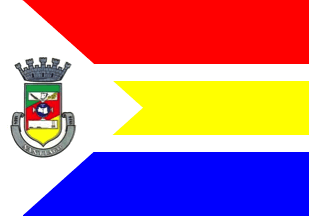 image by Ivan Sache, 4 August 2020
image by Ivan Sache, 4 August 2020
Last modified: 2020-08-08 by ian macdonald
Keywords: rio grande do sul | santiago |
Links: FOTW homepage |
search |
disclaimer and copyright |
write us |
mirrors
 image by Ivan Sache, 4 August 2020
image by Ivan Sache, 4 August 2020
The municipality of Santiago (50,622 inhabitants in 2015, 24,131 ha) is located 450 km of Porto Alegre.
Ivan Sache, 4 August 2020
A horizontal tricolour, red-yellow-blue, each coloured stripe separated by a
narrow white stripe, with the municipal
arms on a white triangle extending from the hoist.
Dirk Schönberger,
25 March 2012
The flag of Santiago is prescribed by Municipal Law No. 263 promulgated on 28
December 1976.
Article 1.
The flag shall be rectangular, in dimensions
160 units in width on 250 units in length.
The colors are red, yellow for the
central field, and blue for the lower stripe.
Yellow represents the
municipality's resources; red represents power, force and impetuosity of people.
Blue represents their spirituality.
On the right, on a white triangle
representing peace, the town's coat of arms in full official colors. The
triangle is spearhead-shaped, representing the municipality's progressive
advance.
https://leismunicipais.com.br/a/rs/s/santiago/lei-ordinaria/1976/27/263/lei-ordinaria-n-263-1976-institui-a-bandeira-do-municipio
Leis Municipais database
The coat of arms of Santiago is prescribed
by Municipal Law No. 52 promulgated on 17 November 1998.
Article 1.
A
Portuguese primitive shield with a five-towered mural crown argent, a symbol of
"cidade", a scroll argent inscribed with the word "Santiago" and the years of
emancipation and elevation to the rank of "cidade".
Tierced per bend
sinister, uniting the upper sinister and lower dexter cantons on the colors of
Rio Grande do Sul.
In chief, the municipality's main sources of income:
soybean, wheat and cattle-breeding.
In base, a primitive mouthpiece and a
building in construction, representing yesterday and today's Santiago.
In the
center, a Cross of Christ brought by Brazil's brave Portuguese discoverers.
On the blue-azure circumference, representing Santiago's sky, four Magen David
representing the districts.
On the white field, above the blue part, the
contour map of the municipality, and, in the center, the monument to the patron
saint, Our Lady of the Conception.
https://leismunicipais.com.br/a/rs/s/santiago/lei-ordinaria/1998/6/52/lei-ordinaria-n-52-1998-altera-o-brasao-de-armas-municipal-de-santiago-e-da-outras-providencias
Leis Municipais database
This superseded the former municipal coat of
arms, which was prescribed by Municipal Law No. 196 promulgated on 9 April 1975.
Article 1.
A Portuguese primitive shield, presenting the following
characteristics.
Surmounted by five-towered mural crown argent, symbol of a
"cidade", in the lower part a papyrus argent inscribed "Santiago", and, on the
left and right, respectively, the municipality's year of foundation and year of
political and administrative emancipation. On the shield in the background, the
colors of the flag of the state of Rio Grande do Sul; in the upper rectangle,
representing the municipality's main sources of income, a bovine's head between
a wheat plant and a soybean plant, in the lower rectangle, a primitive
mouthpiece and a building in construction - yesterday and today's Santiago. In
the center, a Cross of Christ brought by Brazil's brave Portuguese discoverers.
On the blue circumference, representing Santiago's sky, seven white stars
representing the districts, the largest referring to the seat district.
On
the white field, above the blue part, the contour map of the municipality, and,
in the center, the monument to the patron saint, Our Lady of the Conception.
https://leismunicipais.com.br/a/rs/s/santiago/lei-ordinaria/1975/19/196/lei-ordinaria-n-196-1975-adota-novo-brasao-como-simbolo-do-municipio-e-da-outras-providencias
Leis Municipais database
The first coat of arms of Santiago was
prescribed by Municipal Law No. 9 promulgated on 6 August 1969.
Article
1.
An English shield, quartered with a red border, surmounted by a
four-towered mural crown argent. The shield is divided into four quarters, the
1st (on top, dexter) and the 4th (in base, sinister) featuring a half-naked
Indian riding a red horse holding a lasso in the right hand about to throw it,
in the background a green hill; the 2nd quarter (on top, sinister) featuring on
a green field a white Charolais bull in base and a ram in chief; the 3rd quarter
(in base, dexter) featuring on a yellow field black wheat plants. Beneath the
shield a white scroll outlined in black inscribed "1884 / Santiago / 1938". `
Article 2.
The mural crown symbolizes municipal autonomy. The 1st and 4th
quarters represent the region's missionary origin, the heroic war acts that
illustrate the municipality's history, as well as the rural origin, agriculture
and cattle-breeding still being the municipality's main source of income. The
2nd quarters features a bull and a ram, emphasizing the municipality's main
source of income. The 3rd quarter represent the most relevant crop, wheat.
The green and yellow colors are those of the national flag, while green, yellow
and red are those of the flag of Rio Grande do Sul. Yellow also represents
wealth; green is the color of the fields and hope that pushes the struggle for
socio-economic development; red is the color if blood, as a symbol of bravery
expressed by the predecessors in the struggle for the border's fixation [...].
The scroll features year "1884" (Law No. 1,427 promulgated on 4 January 1884
elevated the "freguesia" of Santiago do Boqueirão to a "vila", including the 5th
and 6th districts of São Borja). Sinister, year "1938" (Decree No. 1,799 issued
on 3 March 1938, establishing the state's administrative and judiciary division,
by which the municipality was formed of the districts, Santiago do Boqueirão,
Caroví Flores, Costa do Itú, Ernesto Alves and Carneirinho, the municipality's
seat being elevated to a "cidade" and the two districts of Flores and Ernesto
Alves to a "vila"), and, in the center, "Santiago", the municipality's name.
https://leismunicipais.com.br/a/rs/s/santiago/lei-ordinaria/1969/1/9/lei-ordinaria-n-9-1969-adota-brasao-como-simbolo-do-municipio
Leis Municipais database
Photos
https://www.santiago.rs.gov.br/n/3912
http://visoesdesantiago.blogspot.com/2015/08/
https://expressoilustrado.com.br/todasnoticias/bandeira-vermelha-80-do-comercio-de-santiago-fecha-com-o-novo-decreto
https://www.facebook.com/pmsantiagors/photos/a.1600323860214751/2416173461963116/?type=3&theater
Ivan Sache, 4 August 2020